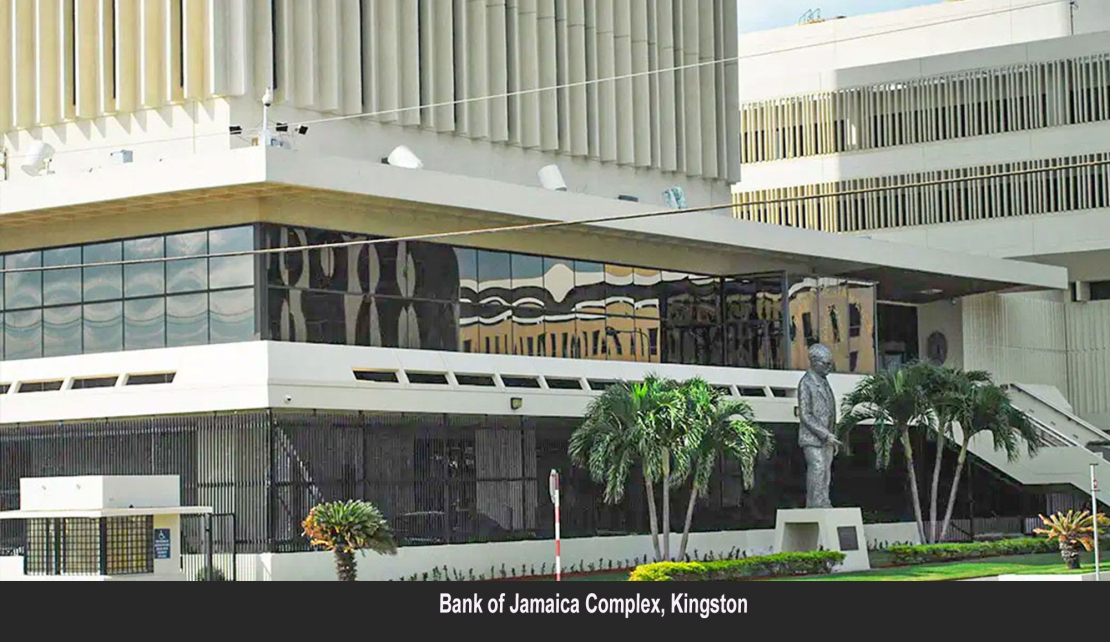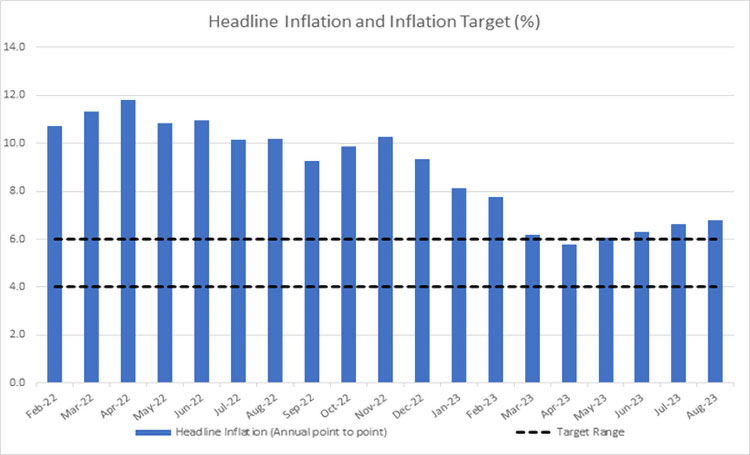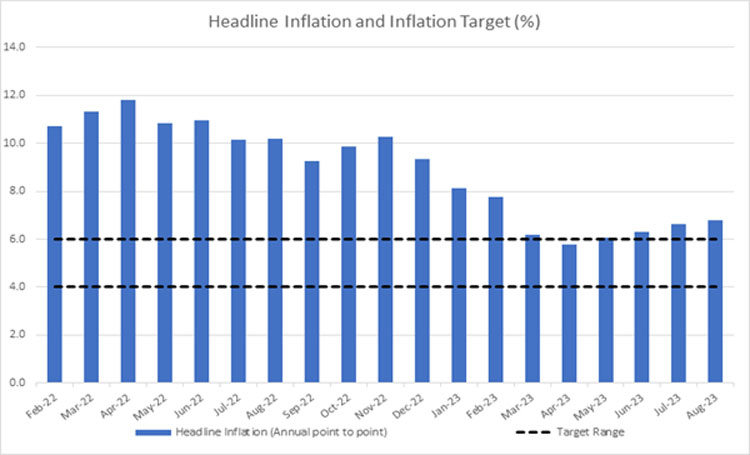Bank of Jamaica Maintains Policy Rate and Heightens Inflation Risk Surveillance

The Bank of Jamaica’s Monetary Policy Committee (MPC), at its meetings on 27 and 28 September 2023, unanimously agreed to maintain: (i) the policy interest rate (the rate offered to deposit-taking institutions (DTIs) on overnight placements with Bank of Jamaica) at 7.0 per cent, (ii) tight Jamaican dollar liquidity conditions, and (iii) stability in the foreign exchange market.
A media release from the Bank of Jamaica says the Committee is, however, prepared to take the necessary actions, including further tightening of monetary policy, if the emerging risks to inflation materialise.
The decision to maintain the monetary policy stance is aimed at ensuring that Jamaica’s inflation rate continues to trend downward to the Bank’s target range of 4.0 to 6.0 per cent.
The annual headline inflation rate at August 2023 of 6.8 per cent was above the outturns at July (6.6 per cent), June (6.3 per cent) and May (6.1 per cent) 2023, but much lower than the peak rate of 11.8 per cent recorded at April 2022.
Correspondingly, core inflation (which excludes food and fuel prices from the Consumer Price Index (CPI)) increased to 5.6 per cent at August 2023 from 5.5 per cent at July 2023, but was lower than the 8.4 per cent recorded at April 2022.

As anticipated by the Bank, the mild uptick in inflation between May and August 2023 was driven by several shocks.
Increases in telephone and internet rates, the national minimum wage and higher agricultural price inflation, along with some upward movement in energy-related prices such as water, electricity and transportation costs, contributed to inflation over the period.
The other key drivers of inflation, such as grains prices, shipping costs and inflation expectations, however, continued to generally trend downward.
The MPC expects that the higher-than-targeted inflation rate over the past four months will continue in September 2023, supported by higher agricultural prices, education costs, oil prices and wage pressures.
While the Bank is still projecting that inflation will decelerate to the target range in the December 2023 quarter and generally remain there except for some months in 2024, it has heightened its surveillance of the risks to this outlook.
The risks to the inflation outlook are skewed to the upside. Higher-than-projected future wage adjustments in the context of continued tightness in the domestic labour market, second-round effects from the sharp increase in agricultural price inflation over the first half of 2023, worsening supply chain conditions and continued increases in world oil prices could put further upward pressure on inflation.
Downside risks to this outlook include weaker-than-expected global growth, which could reduce domestic demand, and the non-materialisation of some projected increases in regulated prices.
Future monetary policy decisions will depend on incoming data related to the strength of the potential headwinds to inflation noted above. As such, the Bank will continue to closely monitor the global and domestic economic environments for these potential risks to Jamaica’s inflation rate.
If the emerging risks materialise, the MPC is prepared to take the necessary actions to anchor inflation sustainably within the target range in the shortest possible time. The date of the next policy decision announcement is 21 November 2023.
A summary of the Monetary Policy Committee’s discussions, which influenced the monetary policy decision, has been published on the Bank’s website at https://boj.org.jm/core-functions/monetary-policy/policy-schedule/summary-of-decisions/.
Summary of Monetary Policy Discussion and Decisions September 2023
At its meetings on 27 and 28 September 2023, the Monetary Policy Committee (MPC) noted the following:
- Jamaica’s annual headline inflation rate at August 2023 of 6.8 per cent was above the outturns at July (6.6 per cent), June (6.3 per cent) and May (6.1 per cent) 2023, but much lower than the peak rate of 11.8 per cent recorded at April 2022. The August outturn was in line with the Bank’s projections. Correspondingly, core inflation (which excludes food and fuel prices from the Consumer Price Index (CPI)) increased to 5.6 per cent from 5.5 per cent at July 2023, but was lower than the 8.4 per cent recorded at April 2022.
- As anticipated, the mild uptick in inflation between May and August 2023 (see chart below) was driven by several shocks. Increases in telephone and internet rates, the national minimum wage and higher agricultural price inflation, along with some upward movement in energy-related prices such as those for water, electricity and transportation, supported inflation over the period. The impetus to energy-related inflation stemmed from international oil prices, which have trended higher than the Bank’s forecast. The other key drivers of inflation, such as grains prices, shipping costs and inflation expectations, however, continued to generally trend downward.
- The business sector’s expectation for inflation 12-months ahead increased to 8.8 per cent relative to 8.3 per cent at May 2023, but was below its peak of 12.8 per cent at April 2022. Survey respondents indicated that changes in the external price of imported goods continued to be the most important factor influencing inflation expectations.
- The higher-than-targeted inflation rate over the past four months is estimated to have continued in September 2023, driven by higher agricultural prices, education costs, oil prices and wage pressures. While the Bank is still projecting that inflation will decelerate to the target range in the December 2023 quarter and generally remain there except for some months in 2024, there are risks to this outlook.
- The risks to the inflation outlook are skewed to the upside. Higher-than-projected future wage adjustments in the context of the tight domestic labour market, second-round effects from the sharp increase in agricultural price inflation over the first half of 2023, worsening supply chain conditions and continued increases in world oil prices, could put further upward pressure on inflation. Downside risks to this outlook include weaker-than-expected global growth, which could reduce domestic demand, and the non-materialisation of some projected increases in regulated prices.
- As anticipated, the United States (US) Federal Reserve Board (Fed) paused its monetary tightening in September 2023 but suggested that interest rates could increase further.
Therefore, to ensure that the inflation rate continues to trend downward to the Bank’s target range, the MPC unanimously agreed to maintain: (i) the policy interest rate at 7.0 per cent, (ii) tight Jamaican dollar liquidity conditions, and (iii) stability in the foreign exchange market. The Committee agreed to heighten surveillance of the risks to the inflation outlook and noted its preparedness to take the necessary actions, including further tightening of monetary policy if the emerging risks to inflation materialise.

The following considerations also informed the MPC’s decisions:
- The outturns for selected external indicators have been mixed. The increase in the average of daily West Texas Intermediate (WTI) crude oil and Liquified Natural Gas (LNG) prices for July and August 2023 was higher than the Bank’s forecast, with the latter increasing by an average monthly rate of 3.3 per cent. Similarly, WTI prices increased by 7.5 per cent for the same period. This increase occurred in the context of additional production cuts by major producers. International fertiliser prices increased by an average monthly rate of 8.3 per cent for July and August 2023. In contrast, average grains prices (wheat, corn, soybean) declined for the period, diverting from the projection for an increase.
- The Jamaican economy continues to expand, which supports increases in aggregate demand for goods and services. Despite the impact of drought conditions on the agriculture sector, Gross domestic product (GDP) for the June 2023 quarter is estimated to have grown within the range of 1.0 to 3.0 per cent, and there are signs that the economy continued to expand in the September 2023 quarter. The notable decline in the unemployment rate as at April 2023 to 4.5 per cent, supported by anecdotal information about wage adjustments in selected private sector industries, indicates that the domestic labour market remains very tight.
- The risks to the domestic GDP forecast are skewed to the downside, which means that actual GDP growth could be lower than the forecast. Growth in tourist arrivals and related activities could be adversely affected by headwinds to global growth. There is also a risk that domestic consumer spending could be negatively affected by the larger-than-expected impact of domestic inflation.
- US GDP growth is likely to be higher than forecasted but is still expected to slow in 2023 relative to 2022. This outlook reflects the impact of high, albeit decelerating, inflation on consumption, tight monetary conditions and reduced fiscal support. Inflation in the US was 3.7 per cent at August 2023, higher than the outturn of 3.2 per cent at July 2023. US inflation is projected to continue to generally fall as the economy slows but remain above the Fed’s target of 2.0 per cent for the remainder of 2023 and 2024.
- As anticipated, the Fed maintained its monetary policy target for interest rates at 5.25 – 5.50 per cent in September 2023, following an increase in July 2023.
- The risks to the outlook for the US economy are balanced. Lower growth could emanate from escalating geopolitical tensions, increased supply shortages, a stronger-than-expected impact of contractionary monetary policy, and the tightening of credit conditions on economic growth. However, higher-than-expected increases in consumption spending could support higher GDP growth.
- The MPC continues to see a relatively strong, lagged pass-through of its policy rate to interest rates in the domestic money and capital markets and the term rates offered on deposits by deposit-taking institutions (DTIs). While the upward adjustment in market rates has slowed, consistent with the MPC’s pause in interest rate increases, rates on time deposits rose further in July. The DTI sector also continued to make small changes to rates on saving deposits and new mortgage loans. Further, the weighted average loan rate increased marginally in July 2023. The flow of new loans to the private sector declined in real terms by 2.0 per cent over the year to July 2023 and, as indicated by DTIs in Bank of Jamaica’s Quarterly Credit Conditions Survey, generally reflected the impact of higher interest rates and tightened credit terms. Local currency deposits grew by 14.6 per cent at July 2023, an acceleration relative to 13.2 per cent in April 2023 and was above the estimated growth in nominal GDP for the September 2023 quarter. In addition, in the context of the stability in the foreign exchange market, deposit dollarisation continued to trend downward.
- The domestic banking system remains sound with adequate capital and liquidity.
- The domestic fiscal policy stance continues to pose no risk to inflation over the near term.
The MPC noted that future monetary policy decisions will depend on incoming data related to the strength of the potential headwinds to inflation noted above. The Bank will continue to closely monitor the global and domestic economic environments for potential risks to Jamaica’s inflation rate and is prepared to take the necessary actions to anchor inflation sustainably within the target range in the shortest possible time.

 Ar
Ar  En
En